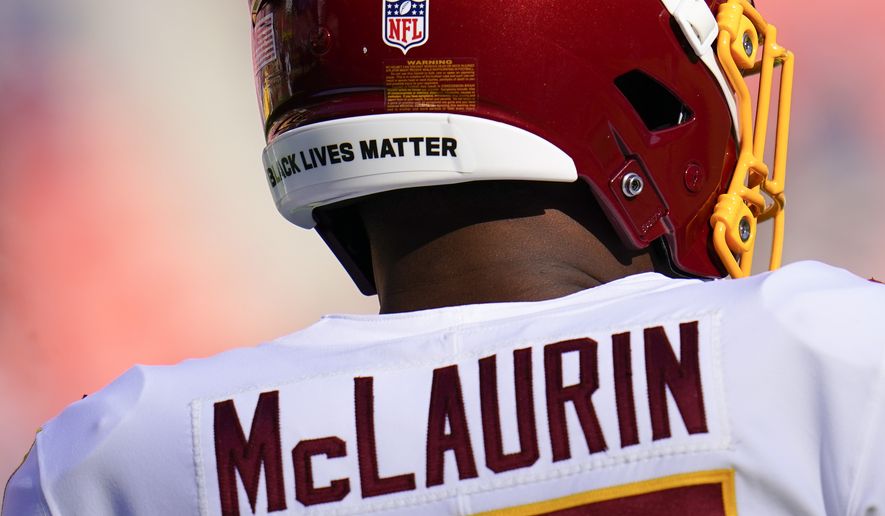Vincent Jackson was once Terry McLaurin — and then some.
Granted, he was a taller version — 6-foot-5, compared to McLaurin at 6 feet, so he didn’t have to go as high to battle for catches. But like McLaurin, he was a talented, respected receiver who was admired by his teammates and committed to his community.
Jackson was a three-time Pro Bowler who was a team captain in Tampa. He had his rocky moments off the field — suspended three games for violating the league’s personal conduct policy in 2010 — but he was the Buccaneers’ Walter Payton Man of the Year for four straight years for his charitable efforts. He finished his 12-year career in 2016 with 540 catches for 9,080 yards and 57 touchdowns.
McLaurin, 26, is a Washington Pro Bowl player-in-waiting. He caught 58 passes for 919 yards and seven touchdowns his rookie year in 2019. He followed that with 87 receptions for 1,118 yards last season and 40 catches for 550 yards in seven games this year. He is a team captain and is active with the team’s support of the nonprofit Youth Entrepreneurs organization.
Jackson was found dead in a hotel room in Brandon, Florida, in February at the age of 38. No cause of death was released, but last week, after cutting open his brain, doctors at the CTE Center in Boston determined Jackson suffered from chronic traumatic encephalopathy.
“His whole plan in the NFL was to set himself up to not have these struggles,” His wife, Lindsey Jackson, told The New York Times. “He had done everything to set up a graceful retirement from football. It’s not the ending he wanted.” She said he had shown symptoms of some of the signs of CTE when he would forget conversations and suffered from depression. He became paranoid and his alcohol consumption increased with those symptoms.
“Vincent Jackson was a brilliant, disciplined, gentle giant whose life began to change in his mid-30s,” Dr. Ann McKee, chief of neuropathology He became depressed, with liberal memory loss, problem-solving difficulties, paranoia, and eventually extreme social isolation. That his brain showed stage 2 CTE should no longer surprise us; these results have become commonplace. What is surprising is that so many football players have died with CTE and so little is being done to make football, at all levels, safer by limiting the number of repetitive subconcussive hits. CTE will not disappear by ignoring it, we need to actively address the risk that football poses to brain health and to support the players who are struggling.”
Jackson claimed he never had a diagnosed concussion.
McLaurin is currently sidelined with at least his second concussion. He suffered one in 2019 near the end of the season against the New York Giants when he went up for a pass and his head hit the FedEx Field grass hard. He had to be helped off the field and was taken into the blue medical tent for examinations. Remarkably, he came back into the game later for one goal-line play. He missed the season finale against Dallas.
This concussion sounds awfully similar to the one McLaurin had last week against Dallas, when his head smashed on the field coming down from an attempt to reel in a pass in the third quarter. He was in concussion protocol, but speculation is that he could play Tuesday night in Philadelphia against the Eagles.
McLaurin likely had at least another concussion in 2018 at Ohio State. He left the Purdue game in the fourth quarter after his head hit the turf after he was tackled after a catch. He was held out of the next game — a 52-51 win over Maryland — but told reporters that doctors kept him out of the Maryland game as a precaution, even though he said he felt pretty normal and didn’t have any concussion-like symptoms the next day.
“Concussion” has become an almost meaningless word. Players have a “concussion” they enter “concussion” protocol and eventually they are healed. It’s part of doing NFL business. More attention is paid now to COVID-19.
But a concussion is a brain injury and should be referred to as such. The player’s brain suffers a trauma when it hits the field like McLaurin’s head has done at least twice at Fed Ex Field and perhaps at least once more in college.
This is what happens when you suffer the sort of brain injury that McLaurin has had. The movement makes the brain bounce and twist around inside the skull, stretching and damaging the cells and structures. Not everyone reacts the same way to brain injuries, and some never suffer the long-term damage that Jackson had.
But: “We’re certainly worried about the accumulative effects of concussions,” said Dr. Gregory Hawryluk, neurosurgeon and concussion specialist at University of Utah Health. “We’re starting to learn that perhaps these seemingly minor blows to the head, when they’re accumulative, can lead to depression and behavior change. In fact, we think that some suicides may be linked to the brain damage that results from multiple concussions.”
McLaurin has had multiple brain injuries in a short period of time — in case anyone is paying attention.
Hear Thom Loverro on The Kevin Sheehan Show podcast.
• Thom Loverro can be reached at tloverro@washingtontimes.com.




Please read our comment policy before commenting.